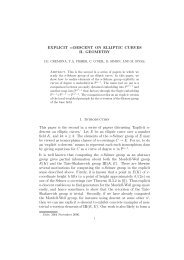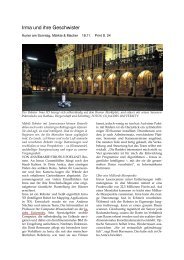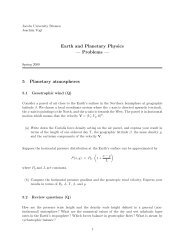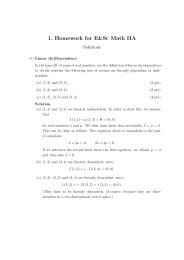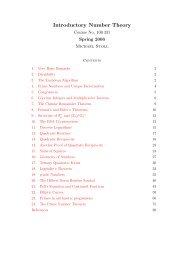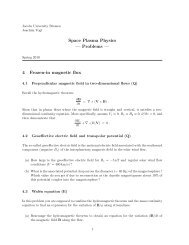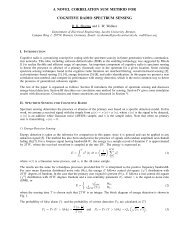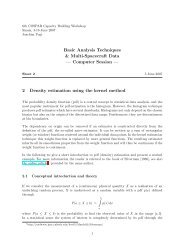Earth and Planetary Physics ? Problems ? 2 Planetary interiors
Earth and Planetary Physics ? Problems ? 2 Planetary interiors
Earth and Planetary Physics ? Problems ? 2 Planetary interiors
You also want an ePaper? Increase the reach of your titles
YUMPU automatically turns print PDFs into web optimized ePapers that Google loves.
Jacobs University Bremen<br />
Joachim Vogt<br />
Spring 2009<br />
2 <strong>Planetary</strong> <strong>interiors</strong><br />
<strong>Earth</strong> <strong>and</strong> <strong>Planetary</strong> <strong>Physics</strong><br />
— <strong>Problems</strong> —<br />
2.1 Heat production of a granite layer (Q)<br />
What is the thickness of a granite layer (density ρ = 2.6 · 10 3 kg m −3 <strong>and</strong> heat production rate<br />
1.07 · 10 −9 J kg −1 s −1 ) that yields the observed heat flow Q = 75 · 10 −3 W m −2 from the <strong>Earth</strong>’s<br />
interior through the surface ?<br />
2.2 Central pressure for uniform density <strong>and</strong> constant gravity (Q)<br />
To obtain a first crude estimate for the pressure Pc at the center of a spherical body, assume not<br />
only the density ρ to be uniform, but also the gravity g to be constant throughout the body (<strong>and</strong><br />
equal to its surface value). Use the hydrostatic equilibrium condition to compute Pc.<br />
2.3 Central pressure for uniform density <strong>and</strong> linear gravity profile (E)<br />
Derive the formula given in class for the pressure Pc at the center of a spherical uniform body<br />
in hydrostatic equilibrium, <strong>and</strong> verify the estimates for the minimum radii of spherical bodies.<br />
(a) Show that the radial gravity profile g = g(r) is linear in the radial coordinate r, i.e.,<br />
g(r) = gs<br />
where gs = −GM/R 2 denotes the surface value of the gravity.<br />
Hint: Note that in general ∇ · g = −4πGρ where ρ is the mass density, <strong>and</strong> G is the<br />
gravitational constant.<br />
(b) The resulting expression for g(r) will be used to integrate the hydrostatic equilibrium<br />
condition, <strong>and</strong> to obtain the radial pressure profile P(r). Express the uniform mass density<br />
ρ in terms of the total mass M of the planet.<br />
1<br />
r<br />
R
(c) To estimate the minimum radii of (quasi-)spherical objects, insert numerical values of<br />
the material strengths for Pc. For rocky bodies, use ∼ 2 · 10 8 Pa <strong>and</strong> an (uncompressed)<br />
density ρ = 3.5 · 10 3 kg/m 3 . For iron bodies, the material strength is ∼ 4 · 10 8 Pa <strong>and</strong><br />
ρ = 7.9 · 10 3 kg/m 3 .<br />
2.4 <strong>Earth</strong>’s moment of inertia <strong>and</strong> core density (E)<br />
Use the values RE <strong>and</strong> ME of the spherical <strong>Earth</strong> model <strong>and</strong> the core radius Rc = 3480 km (infered<br />
from seismological recordings) to determine the core density ρc <strong>and</strong> the mantle density<br />
ρm of a simplified two-layer model of the <strong>Earth</strong>’s interior. The model comprises only the mantle<br />
<strong>and</strong> the core. Suppose that both regions are characterized by homogeneous mass density<br />
functions ρm <strong>and</strong> ρc.<br />
Obviously, you need additional information to solve the problem.<br />
(a) Use a typical surface rock density value as a proxy for the mantle density (ρm = 3 g/cm 3 )<br />
<strong>and</strong> then determine ρc.<br />
(b) Compute the moment of inertia for the spherical two-layer <strong>Earth</strong> model <strong>and</strong> identiy this<br />
theoretical value with the measured value of the <strong>Earth</strong>’s (main) moment of inertia C given<br />
in class. Now determine, both, the mantle density ρm <strong>and</strong> the core density ρc from the two<br />
equations for the total mass <strong>and</strong> the total angular momentum.<br />
Hint: The equations become simpler if normalized variables are used. For normalization of the<br />
densities you may use the mean density of the whole <strong>Earth</strong>:<br />
ρ E =<br />
mass of the <strong>Earth</strong><br />
volume of the <strong>Earth</strong><br />
<strong>and</strong> the core radius can be normalized by RE. This yields<br />
ˆρm = ρm/ρ E ,<br />
ˆρc = ρc/ρ E ,<br />
ˆRc = Rc/RE .<br />
3ME<br />
=<br />
4πR3 ,<br />
E<br />
2.5 Temperature, pressure, <strong>and</strong> density in the <strong>Earth</strong>’s mantle [H3]<br />
In this problem you are supposed to determine approximately the profiles of temperature T,<br />
pressure P, <strong>and</strong> mass density ρ in the <strong>Earth</strong>’s mantle.<br />
(a) In order to find the temperature profile T = T(r), assume that the gradient is adiabatic:<br />
<br />
dT <br />
<br />
α g<br />
= − T .<br />
dr<br />
cp<br />
adiab<br />
2
Use constant values for the parameters in this equation: gravity g = 9.81 m s −2 = go<br />
(surface value), specific heat (at constant pressure) cp = 10 3 J kg −1 K −1 , <strong>and</strong> thermal expansion<br />
coefficient α = 3 · 10 −5 K −1 . The temperature boundary condition at the surface<br />
is To = 300 K.<br />
(b) Compute P = P(r) <strong>and</strong> ρ = ρ(r) using the hydrostatic equilibrium condition <strong>and</strong> a fixed<br />
value of the adiabatic compressibility: β = 4.3 · 10−12 Pa −1 . Note that<br />
β = 1<br />
<br />
∂ρ <br />
.<br />
ρ ∂P<br />
adiab<br />
The boundary values are ρo = 3.3 · 10 3 kg m −3 <strong>and</strong> Po = 0 Pa.<br />
(c) Plot ρ, P <strong>and</strong> T as functions of radial distance r.<br />
2.6 Interior of gas giants [H3]<br />
This is problem 6.28 in the textbook <strong>Planetary</strong> Sciences of Imke de Pater <strong>and</strong> Jack J. Lissauer.<br />
Approximate Jupiter <strong>and</strong> Saturn by pure hydrogen spheres, with an equation of state P = Kρ 2<br />
<strong>and</strong> K = 2.7 · 10 12 cm 5 g −1 s −2 .<br />
(a) Determine the moment of inertia for the planets.<br />
(b) Assume the planets each have a core of density 10 g cm −3 , <strong>and</strong> the moment of inertia<br />
I/MR 2 = 0.253 for Jupiter <strong>and</strong> 0.227 for Saturn. Determine the mass of the cores.<br />
Submission due date for homework problems: 9 March 2009<br />
3



